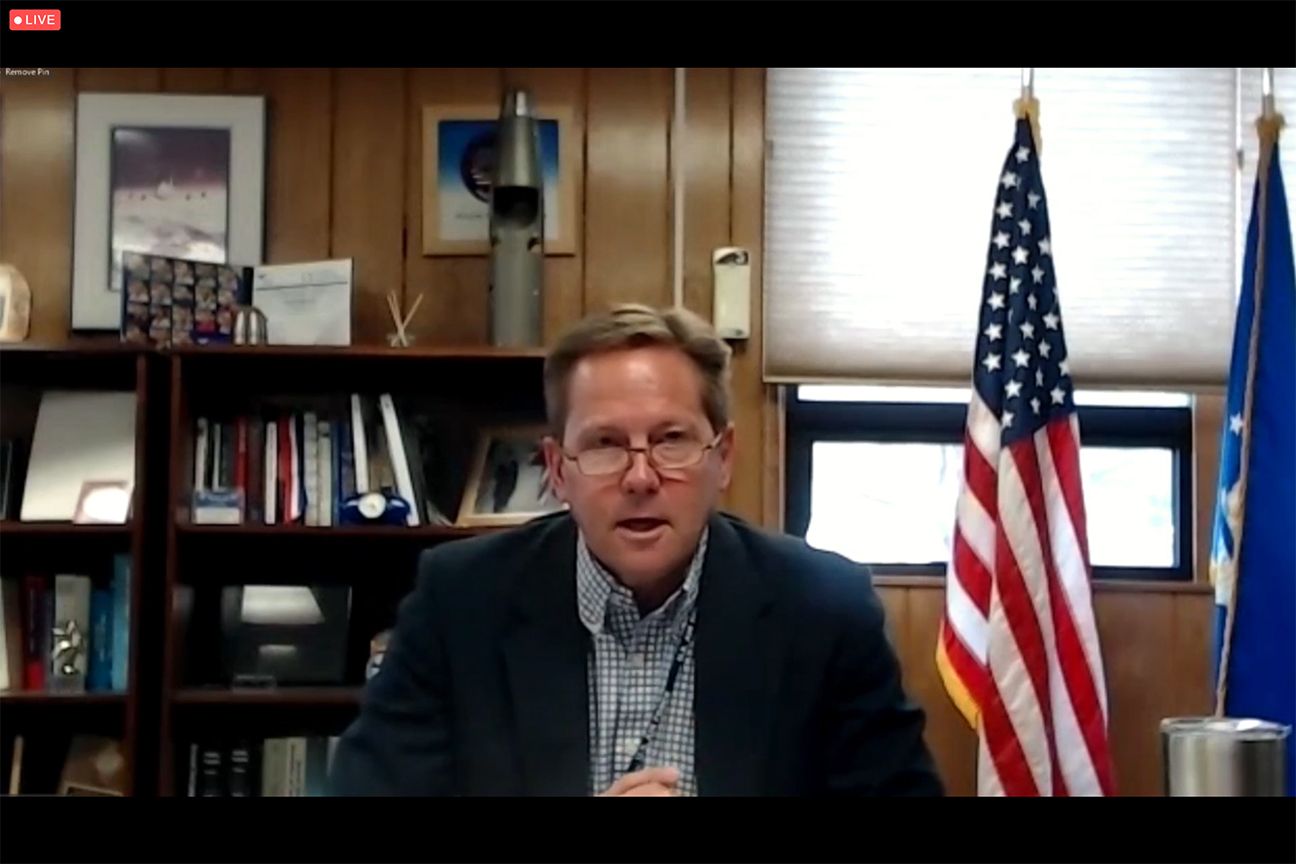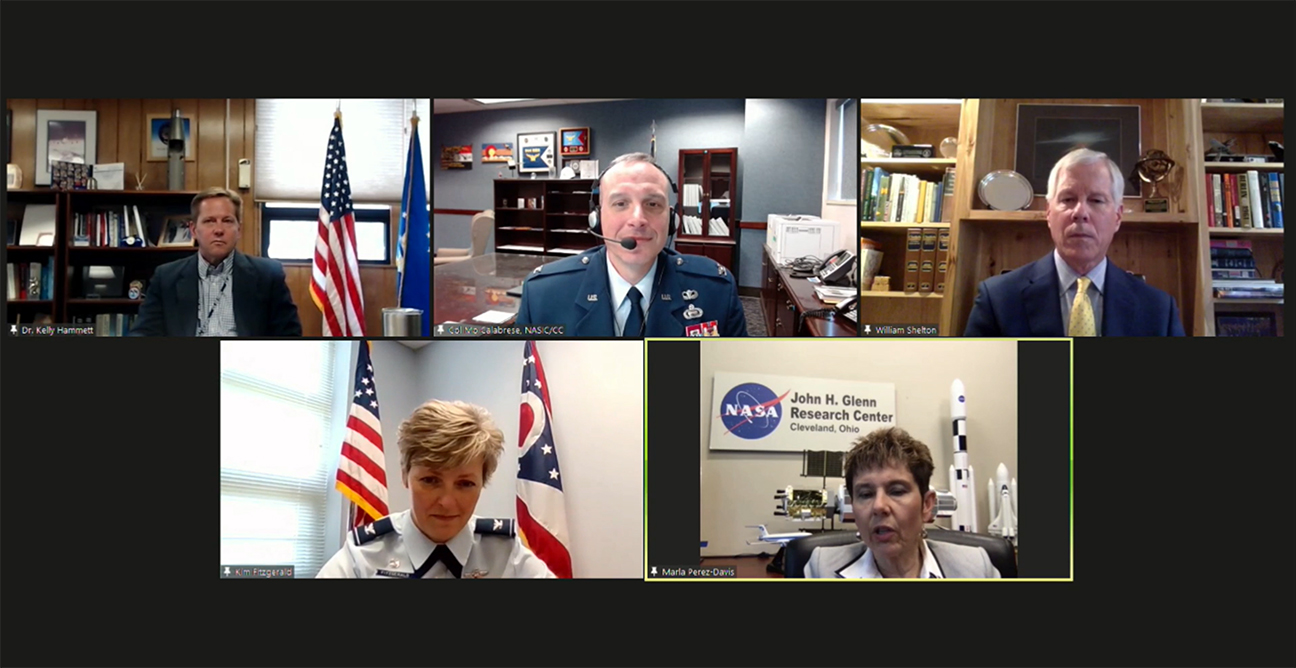Air Force Deputy Technology Executive Officer Addresses Ohio Space Forum
WRIGHT-PATTERSON AIR FORCE BASE, Ohio (AFRL) – The Air Force Research Laboratory’s Dr. Kelly Hammett spoke at the annual Ohio Space Forum May 18, joining several aerospace leaders who discussed their organizations’ contributions to the space mission and Ohio politicians who lauded Ohio’s contributions and their economic impact.
Facilitated by the Dayton Development Coalition and JobsOhio, the Ohio Space Forum gathers federal, military, industry and academic leaders in space research, operations, intelligence, exploration and defense. The forum serves to provide insights into the importance of space to our national security as well as a greater understanding of Ohio’s critical role in achieving the nation’s defense and space exploration objectives. Ohio ranks among the top-ten highest nationally funded states for space exploration research and development, said NASA Associate Administrator Steve Jurczyk during his keynote address.
“Ohio has been and continues to be a space leader, and it sounds like Ohio is on its way to becoming #1 in aerospace innovation,” Jurczyk said. “It’s an incredibly exciting time to be in aerospace, and there is just tremendous opportunity.”
Although typically an in-person event, this year’s forum was held virtually with a welcome provided by Ohio Governor Mike DeWine and a full day of various speakers, panels, and fireside chats.
In the afternoon, Lt. Col. Walter “Rock” McMillan provided an update on SpaceWERX, an Air Force program newly launched in December. To close the day, U.S. Rep. Mike Turner hosted Lt. Gen. John Thompson, commander of the Space and Missile Systems Center for a fireside chat.
Hammett spoke as part of the forum’s military and federal perspectives panel, about AFRL, headquartered at Wright-Patterson Air Force Base, and its response to the threat of United States near-peer adversaries’ weaponization of space. In response to a wider acknowledgment of space as a war-fighting domain, the U.S. Space Force has issued new doctrinal guidance to the rest of the Department of the Air Force. The Lab will not be broken up, Hammett said, citing AFRL Commander Maj. Gen. Heather Pringle’s priority of “One AFRL, two services.” Procedural changes have included the establishment of a Space Science and Technology group and board that allow AFRL to better integrate across its entire portfolio.
During the past eight months, in addition to Hammett’s longer-held position as director of the Air Force Research Laboratory’s Directed Energy Directorate, he has served as the Air Force’s deputy technology executive officer for space science and technology. As deputy TEO, he chairs the Space S&T board, acts as a single voice on behalf of AFRL to the Space Force customer for S&T activities, ensures AFRL is being responsive to the changing priorities and works closely with the Space Force’s chief scientist and chief technology and innovation officer to prioritize across the portfolio.
In this role he’s established three objectives for fiscal year 2021: division of assets and personnel, realignment of programs and investments, and a strategic messaging campaign. In response to the Secretary of the Air Force earmarking assets for transfer from the Air Force to the Space Force, 700 AFRL personnel will soon be attached to Space Systems Command when it formally activates and reassigned back to the Lab for day-to-day execution. This means 10 percent of the Air Force’s annual S&T appropriated budget will also be transferred to cover program management oversight. These personnel will mainly be pulled from AFRL’s Space Vehicles Directorate, Space Electro-optics Division within the Directed Energy Directorate and the rocket laboratory at Edwards Air Force Base. In addition, investments and programs are being mapped to the Space Force’s 14 newly established technical thrust areas. To communicate all of these changes, Hammett has been working closely with Pringle to develop a strategic messaging campaign.
“Having one AFRL supporting both services has allowed AFRL to be the Department of the Air Force spokesman to all of the other DOD and civilian agencies that are doing space S&T, and we’ve been working very hard, using this internal alignment and governance process to build and strengthen our partnerships with those other space S&T activities,” Hammett said.
Hammett explained a myriad of AFRL and Air Force programs involved in space S&T, such as SpaceWERX; Air Force Vanguard Navigation, Technology Satellite-3; the Air Force Office of Scientific Research and Wright-Patterson Air Force Base’s Center for Rapid Innovation.
SpaceWERX, allotted as a space arm of AFWERX, an AFRL program that fosters investment in entrepreneurial innovation, will soon feature a newly built hub co-located with the Space and Missile Systems Center. Further adding to SpaceWERX development, McMillan, who leads SpaceWERX and serves as the Space Force’s chief of innovation, will announce a SpaceWERX Prime this summer. Analogous to AFWERX’s Agility Prime, SpaceWERX Prime works to rapidly drive affordable capability.
As part of the Air Force’s 2030 S&T Strategy, AFRL also established a Transformational Capabilities Office, which manages the 20 percent of AFRL’s budget that aligns transformational capabilities with priority needs.
The Lab will double investments in space-cyber S&T out of its Information Directorate and space-focused research out of AFOSR. A space research university initiative has been formed out of AFOSR as well as a Space Force-led academic consortium that involves 10 universities.
“You can see there is a lot of change going on in Space Force and all of the S&T organizations in response to that. We are trying to leverage all partnerships in science and technology that will help us get after the mission.”
In addition, AFRL organizations are working on machine-to-machine connections of sensors, artificial intelligence/machine learning and autonomy, digital transformation and architecture-wide, multi-domain modeling and simulation and analysis to support space warfighting and assessment and overall architectural developments.
The Air Force also defined new initiatives for an on-orbit service in mobility and logistics with hopes of a joint effort with NASA’s John H. Glenn Research Center in Ohio. The AFRL rocket lab has also been qualifying new responsive launch providers to get assured and rapid access to space.
Lastly, Hammett mentioned near-peer adversaries moving outside of the geo-stationary belt as a driver for future technology and investment.
“We have to pivot to that,” he said. “We have to lay out an architecture that will be able to track what’s going on out there, be able to respond. There’s been a question over whether we would protect a global commons, like the Navy protects the seas—whether we would protect the space domain, and it looks like that has been determined. We have to develop a whole new set of capabilities to have eyes and ears and actionable options and opportunities.”

Dr. Kelly Hammett, director of the Air Force Research Laboratory’s Directed Energy Directorate and deputy technology executive officer for Air Force space science and technology, spoke virtually to Ohio Space Forum attendees on May 18 about the many ways AFRL is supporting the space mission. (Photo screenshot by Leslie Heck, AFRL Public Affairs)

The Air Force Research Laboratory’s Dr. Kelly Hammett (top left) participates in the Ohio Space Forum’s military and federal perspectives panel on May 18, moderated by Gen. (ret.) William Shelton (top right), former commander of Air Force Space Command, along with fellow panelists Col. Mo Calabrese (top center), commander of the National Air and Space Intelligence Center; Dr. Marla Perez-Davis (bottom right), director of NASA’s John H. Glenn Research Center and Col. Kimberly Fitzgerald (bottom left), commander of the 178th Wing. (Photo screenshot by Leslie Heck, AFRL Public Affairs)
